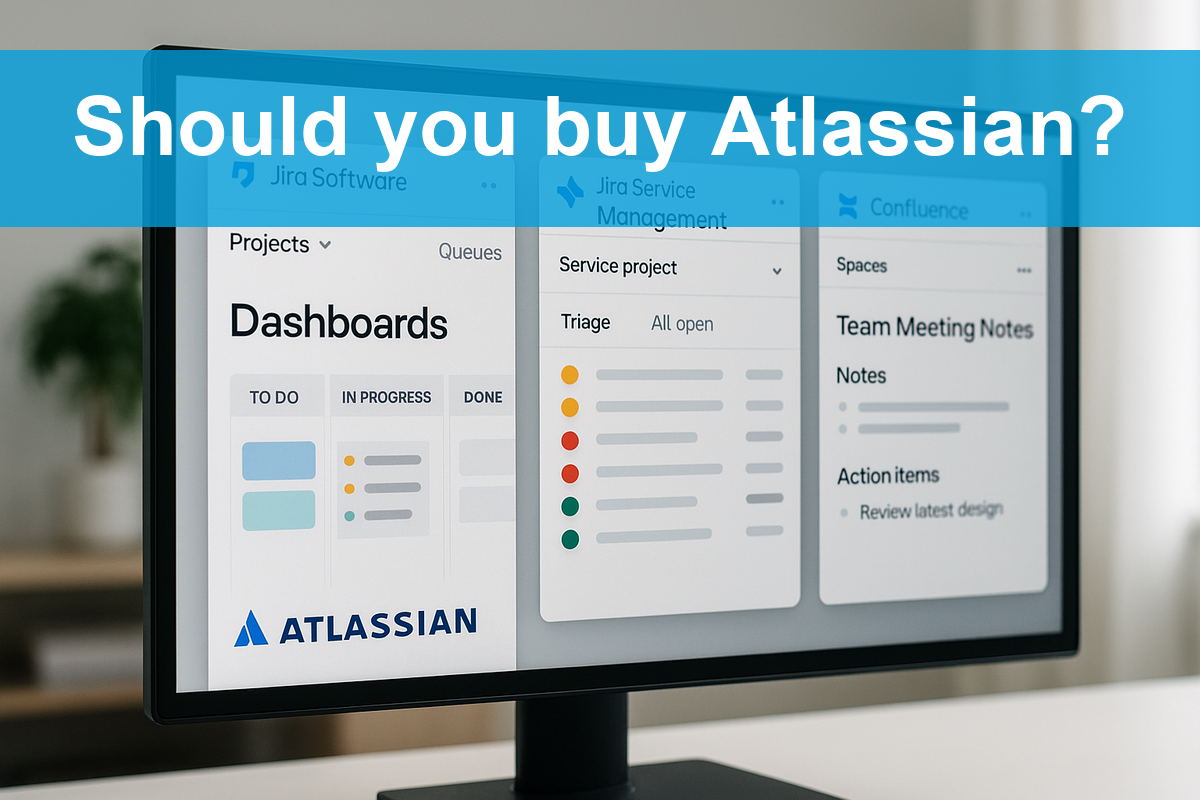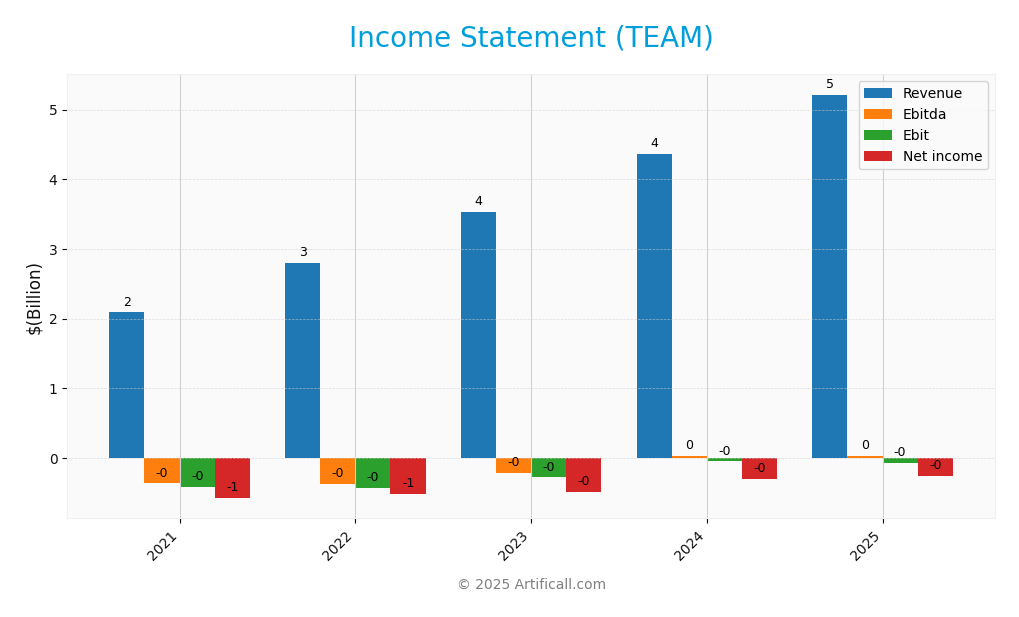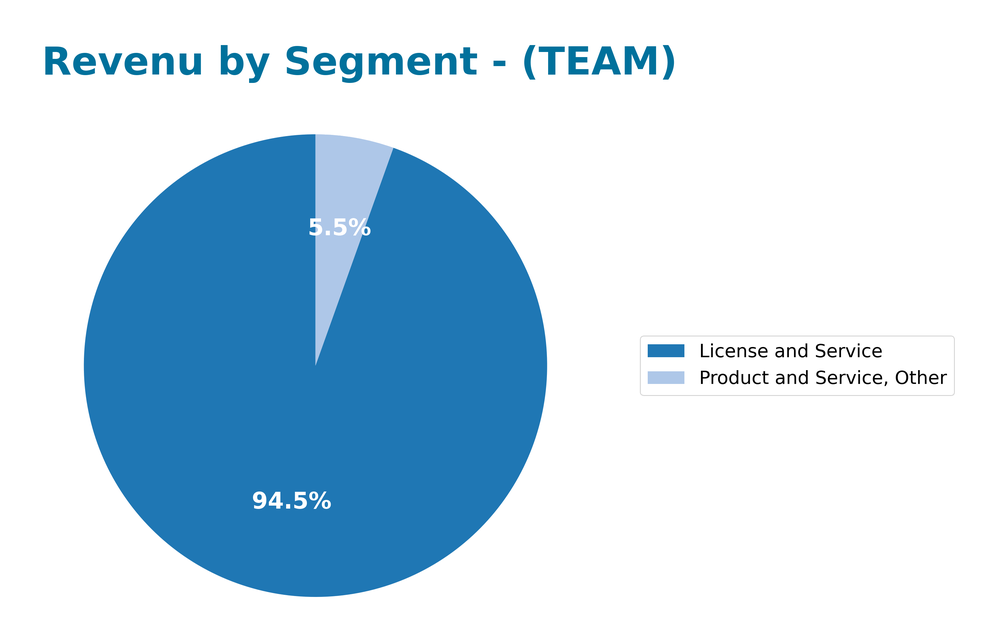Atlassian Corporation is revolutionizing how teams collaborate and manage projects, transforming daily workflows for millions around the globe. Renowned for its flagship products like Jira and Confluence, Atlassian stands at the forefront of the software application industry, constantly pushing the envelope of innovation and quality. With a reputation for empowering diverse teams, I now question whether Atlassian’s robust fundamentals continue to justify its current market valuation amidst evolving industry challenges and opportunities.

Table of contents
Company Description
Atlassian Corporation, founded in 2002 and headquartered in Sydney, Australia, is a prominent player in the software application industry. With a market capitalization of approximately $39.83B, the company specializes in developing a suite of collaboration and project management tools, including Jira Software, Confluence, and Trello. These products facilitate seamless communication and organization across technical and business teams, positioning Atlassian as a leader in enhancing workplace productivity. The company operates primarily in North America, Europe, and the Asia-Pacific region, with a diverse portfolio that spans software solutions and services. Atlassian’s commitment to innovation and user-centric design plays a crucial role in shaping the future of teamwork and collaboration in the digital age.
Fundamental Analysis
This section will analyze Atlassian Corporation’s income statement, key financial ratios, and dividend payout policy to assess its investment potential.
Income Statement
The following table summarizes the income statement for Atlassian Corporation over the past five fiscal years, highlighting key financial metrics.

| Metric | 2021 | 2022 | 2023 | 2024 | 2025 |
|---|---|---|---|---|---|
| Revenue | 2.09B | 2.80B | 3.53B | 4.36B | 5.22B |
| Cost of Revenue | 331.85M | 452.91M | 633.77M | 803.50M | 894.85M |
| Operating Expenses | 1.62B | 2.28B | 3.25B | 3.67B | 4.45B |
| Gross Profit | 1.76B | 2.35B | 2.90B | 3.56B | 4.32B |
| EBITDA | -365.88M | -377.73M | -220.07M | 27.41M | 24.03M |
| EBIT | -421.83M | -429.47M | -280.99M | -51.33M | -68.35M |
| Interest Expense | 92.59M | 41.47M | 30.15M | 34.08M | 30.55M |
| Net Income | -578.98M | -519.51M | -486.76M | -300.52M | -256.69M |
| EPS | -2.79 | -2.42 | -1.90 | -1.16 | -0.98 |
| Filing Date | 2021-08-13 | 2022-08-19 | 2023-08-18 | 2024-08-16 | 2025-08-15 |
Over the past five years, Atlassian has shown a consistent upward trend in revenue, increasing from 2.09B in 2021 to 5.22B in 2025, indicating robust growth potential. However, net income remains negative, though it has improved from -579M in 2021 to -257M in 2025. The margins have shown some stability, with a slight increase in gross profit margin. In 2025, the company faced higher operating expenses, impacting profitability, but the reduction in net losses suggests potential operational efficiencies are being realized. As an investor, I recommend keeping an eye on how Atlassian manages its costs moving forward.
Financial Ratios
The table below summarizes the key financial ratios for Atlassian Corporation (TEAM) over the last available years.
| Ratios | 2021 | 2022 | 2023 | 2024 | 2025 |
|---|---|---|---|---|---|
| Net Margin | -27.71% | -18.53% | -13.77% | -6.89% | -4.92% |
| ROE | -91.38% | -162.73% | -74.33% | -85.64% | -19.06% |
| ROIC | -22.79% | -21.54% | -13.80% | -11.63% | -2.53% |
| P/E | -110.72 | -145.01 | -88.32 | -153.70 | -207.13 |
| P/B | 217.36 | 145.01 | 65.67 | 44.72 | 39.51 |
| Current Ratio | 0.70 | 1.19 | 1.35 | 1.18 | 1.22 |
| Quick Ratio | 0.70 | 1.19 | 1.35 | 1.18 | 1.22 |
| D/E | 2.05 | 4.02 | 1.96 | 1.21 | 0.92 |
| Debt-to-Assets | 0.21 | 0.40 | 0.31 | 0.24 | 0.21 |
| Interest Coverage | 1.53 | 1.69 | -11.45 | -3.44 | -4.27 |
| Asset Turnover | 0.71 | 0.84 | 0.86 | 0.84 | 0.86 |
| Fixed Asset Turnover | 7.69 | 7.42 | 13.31 | 16.84 | 19.02 |
| Dividend Yield | 0% | 0% | 0% | 0% | 0% |
Interpretation of Financial Ratios
In 2025, Atlassian’s financial ratios reveal significant challenges. The net margin remains negative at -4.92%, indicating ongoing profitability issues. The high P/E ratio of -207.13 suggests investor skepticism about future earnings. Although the current and quick ratios above 1 indicate adequate liquidity, the high debt-to-equity ratio of 0.92 could raise concerns about leverage and financial risk.
Evolution of Financial Ratios
Over the past five years, Atlassian’s financial ratios have shown a trend of improving net margins and liquidity, yet profitability remains a concern. The debt-to-equity ratio has decreased, indicating better leverage management, but the overall financial health necessitates close monitoring for potential risks.
Distribution Policy
Atlassian Corporation (TEAM) does not currently pay dividends, primarily due to its ongoing reinvestment strategy aimed at supporting growth and innovation. The company is in a high-growth phase, prioritizing R&D and acquisitions over returning capital to shareholders. Additionally, TEAM engages in share buybacks, indicating a commitment to returning value, albeit indirectly. This strategy aligns with long-term shareholder value creation, as it positions the company for future profitability and market expansion.
Sector Analysis
Atlassian Corporation operates in the Software – Application industry, focusing on project management and collaboration tools like Jira and Confluence, competing with major players such as Microsoft and Asana.
Strategic Positioning
Atlassian Corporation (TEAM) holds a strong position in the software application market, particularly with its flagship products like Jira and Confluence. With a market capitalization of approximately $39.8B, the company continues to face competitive pressure from other software firms but maintains a significant market share in project management and collaboration tools. The ongoing technological disruption in cloud computing and enterprise software presents both challenges and opportunities; I must monitor how Atlassian adapts and innovates to stay ahead in this rapidly evolving landscape.
Revenue by Segment
The following chart illustrates Atlassian Corporation’s revenue distribution by segment for the fiscal year 2025, highlighting key areas of growth and contribution.

In FY 2025, Atlassian’s primary revenue driver remains the “License and Service” segment, generating 4.93B, a significant increase from 3.92B in FY 2024. The “Product and Service, Other” segment contributed 285M, reflecting a slight uptick compared to the previous year. This upward trend in the core segment indicates robust demand for Atlassian’s offerings, although the growth rate may be moderating, suggesting potential margin pressures as competition intensifies. Overall, the company continues to show resilience, but stakeholders should remain cautious of market dynamics that could impact profitability moving forward.
Key Products
Atlassian Corporation offers a diverse range of software products designed to enhance collaboration and project management across teams. Below is a table summarizing their key products:
| Product | Description |
|---|---|
| Jira Software | A project management tool that connects technical and business teams for better planning, organizing, tracking, and managing projects. |
| Confluence | A connected workspace that organizes knowledge across teams, facilitating seamless collaboration and project advancement. |
| Trello | A visual collaboration tool that helps teams organize tasks and projects through boards, lists, and cards. |
| Jira Service Management | An intuitive service desk product that enables service teams (IT, HR, legal) to create and manage service experiences efficiently. |
| Jira Align | An enterprise agility solution designed to help businesses respond to dynamic conditions while focusing on value creation. |
| Bitbucket | An enterprise-ready Git solution that allows development teams to manage, collaborate, and deploy quality code effectively. |
| Atlassian Access | A centralized administration tool that enhances security across all Atlassian cloud products for enterprise users. |
| Opsgenie | An on-call and alert management software that helps teams respond to incidents promptly and efficiently. |
| Bamboo | A continuous delivery pipeline that automates the release process and ensures high-quality software delivery. |
| Statuspage | A communication tool that provides real-time status updates to users regarding system performance and incidents. |
This assortment of products showcases Atlassian’s commitment to improving team collaboration and project management, making it a significant player in the software industry.
Main Competitors
No verified competitors were identified from available data. However, I estimate that Atlassian Corporation holds a significant market share in the Software – Application industry, particularly with its robust portfolio of collaboration and project management tools. The company is well-positioned in its sector, emphasizing a strong competitive position through its innovative products like Jira Software, Confluence, and Trello, catering to a global market.
Competitive Advantages
Atlassian Corporation (TEAM) holds a strong market position in the software application industry, primarily due to its innovative product suite that enhances collaboration and project management. The company’s flagship products, such as Jira and Confluence, are widely adopted across various sectors, providing a competitive edge through integrated solutions that streamline workflows. Looking ahead, Atlassian’s commitment to expanding its portfolio with new features and entering emerging markets presents significant growth opportunities. Additionally, advancements in AI integration within their platforms may further enhance user experience and productivity, positioning Atlassian favorably for future developments.
SWOT Analysis
This SWOT analysis aims to evaluate Atlassian Corporation’s internal and external factors affecting its market position.
Strengths
- Strong product portfolio
- High customer retention
- Innovative technology
Weaknesses
- No dividends paid
- Dependence on software subscriptions
- Potential market saturation
Opportunities
- Expansion into emerging markets
- Growth in remote work solutions
- Strategic partnerships
Threats
- Intense competition
- Economic downturn risks
- Rapid technological changes
The overall SWOT assessment indicates that while Atlassian has a robust product lineup and significant opportunities for growth, it must navigate competitive pressures and economic uncertainties. Strategic focus on innovation and market expansion will be crucial for sustaining its competitive edge.
Stock Analysis
Over the past year, Atlassian Corporation (ticker: TEAM) has experienced significant price movements, culminating in a notable bearish trend characterized by a decline in its stock price.

Trend Analysis
Analyzing the stock’s performance over the past two years, I note a price change of -36.96%, indicating a bearish trend. This trend has been marked by deceleration, with the stock’s highest price reaching 314.28 and its lowest at 141.43. The standard deviation of 39.76 suggests a considerable level of volatility during this period. More recently, from August 31, 2025, to November 16, 2025, the stock has further declined by -14.62%, confirming the bearish sentiment with a trend slope of -1.88.
Volume Analysis
Examining the trading volumes over the last three months, I observe an average volume of approximately 13.84M, with average sell volume at 7.70M, outpacing average buy volume at 6.14M. This indicates a seller-dominant market, suggesting that investor sentiment is leaning towards selling rather than buying. The volume trend appears bullish, albeit in the context of seller dominance, with a positive trend slope of 577.87K, indicating increasing trading activity overall.
Analyst Opinions
Recent analyst recommendations for Atlassian Corporation (TEAM) indicate a cautious stance, with a consensus rating of “Hold” for 2025. Analysts have expressed concerns over the company’s low scores in return on equity, return on assets, and debt-to-equity ratios, leading to an overall score of 2. Notably, the discounted cash flow score of 5 suggests potential but requires careful evaluation. Analysts urge investors to monitor performance closely before making significant commitments.
Stock Grades
Atlassian Corporation (TEAM) has received consistent evaluations from several reputable grading companies, maintaining a generally positive outlook.
| Grading Company | Action | New Grade | Date |
|---|---|---|---|
| Macquarie | maintain | Outperform | 2025-11-03 |
| Mizuho | maintain | Outperform | 2025-10-31 |
| Bernstein | maintain | Outperform | 2025-10-31 |
| TD Cowen | maintain | Hold | 2025-10-27 |
| UBS | maintain | Neutral | 2025-10-24 |
| BMO Capital | maintain | Outperform | 2025-10-24 |
| Keybanc | maintain | Overweight | 2025-10-23 |
| Canaccord Genuity | maintain | Buy | 2025-10-22 |
| BWG Global | upgrade | Positive | 2025-10-14 |
| Citigroup | maintain | Buy | 2025-08-18 |
Overall, the trend in grades for Atlassian Corporation is positive, with multiple firms maintaining an “Outperform” rating. This indicates a strong consensus among analysts regarding the company’s performance potential in the near future.
Target Prices
The consensus target prices for Atlassian Corporation (TEAM) reflect a positive outlook among analysts.
| Target High | Target Low | Consensus |
|---|---|---|
| 300 | 185 | 232.85 |
Overall, analysts expect Atlassian’s stock to reach around 232.85, indicating a strong potential for growth within the specified range.
Consumer Opinions
Consumer sentiment towards Atlassian Corporation (TEAM) reflects a mix of enthusiasm and criticism, showcasing how users perceive the company’s products and services.
| Positive Reviews | Negative Reviews |
|---|---|
| “Atlassian’s tools have transformed our workflow efficiency.” | “Customer service is lacking and slow to respond.” |
| “The integration capabilities are top-notch.” | “Some features are complicated and hard to navigate.” |
| “Great collaboration tools for remote teams!” | “Pricing can be steep for small businesses.” |
Overall, consumer feedback indicates strong appreciation for Atlassian’s collaboration tools and integrations, while concerns about customer service and pricing are recurring weaknesses.
Risk Analysis
In this section, I present a table summarizing the key risks associated with investing in Atlassian Corporation (TEAM), along with an analysis of their likelihood and potential impact.
| Category | Description | Probability | Impact |
|---|---|---|---|
| Market Volatility | Fluctuations in tech sector valuations | High | High |
| Competitive Pressure | Increasing competition from other software firms | Medium | High |
| Regulatory Changes | Potential changes in data privacy regulations | Medium | Medium |
| Cybersecurity Threats | Risk of data breaches affecting user trust | High | High |
| Economic Downturn | Global economic instability affecting budgets | Medium | High |
The most significant risks for TEAM involve market volatility and cybersecurity threats, both of which have the potential for substantial impact on performance. Given the current economic climate, these factors warrant careful consideration in your investment strategy.
Should You Buy Atlassian Corporation?
Atlassian Corporation (TEAM) is known for its flagship products like Jira and Confluence, which dominate the project management and collaboration software market. However, the company faces recent challenges, including a negative net margin (-4.92%) and a return on invested capital (ROIC) that doesn’t exceed its weighted average cost of capital (WACC) of 7.81%.
Given the current financial indicators, Atlassian’s negative net margin and ROIC below WACC suggest it may not be the best time to invest. The long-term trend appears bearish with a significant price decline of about 36.96%, and there is a concerning shift towards seller dominance in volume, indicating a lack of buyer confidence. Therefore, I recommend waiting until the fundamentals show improvement and a bullish reversal is evident before considering a position in this stock.
Specific risks include competitive pressures in the software sector and ongoing valuation challenges that may impact future growth.
Disclaimer: This article is not financial advice. Each investor is responsible for their own investment decisions.
Additional Resources
- Sustainable Growth Advisers LP Raises Holdings in Atlassian Corporation PLC $TEAM – MarketBeat (Nov 16, 2025)
- Is Atlassian Corporation (NASDAQ:TEAM) Trading At A 40% Discount? – Yahoo Finance (Nov 15, 2025)
- Atlassian: Software’s New Value Play (NASDAQ:TEAM) – Seeking Alpha (Nov 12, 2025)
- Candriam S.C.A. Grows Position in Atlassian Corporation PLC $TEAM – MarketBeat (Nov 16, 2025)
- Atlassian Corporation (TEAM) Declined Despite Solid Results And Guidance – Yahoo Finance (Nov 10, 2025)
For more information about Atlassian Corporation, please visit the official website: atlassian.com



